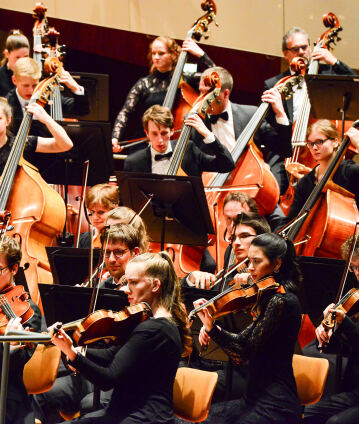The National Youth Orchestra of Germany and Ingo Metzmacher with the “Alpine Symphony”

Following its performance under the direction of Kirill Petrenko, the National Youth Orchestra of Germany is now making its second appearance at the Philharmonie to mark its 50th birthday – this time under the baton of Ingo Metzmacher. In the two works he conducts, two opposing worlds collide: the loud, vibrant, dynamic urban life of New York, portrayed musically by Edgard Varèse in his orchestral work Amériques, and the rural, contemplative world of the Bavarian mountains depicted by Richard Strauss in his Alpine symphony.
The National Youth Orchestra of Germany offers highly talented instrumentalists between the ages of 14 and 19 the possibility to gain initial experience in orchestra playing – under professional conditions. Founded in 1969 by the Deutscher Musikrat (German Music Council), the orchestra can look back this season on a 50-year success story. The course is often set here for a future as a professional musician: not only because many former “BJO” members, such as for instance Sabine Meyer, Christian Tetzlaff and Tabea Zimmermann, now successfully perform as soloists, but also because, thanks to the exciting and intensive rehearsal and performance phases, many participants decide to embark on the career of an orchestral musician. Many members of the Berliner Philharmoniker, which assumed patronage of the young top-class ensemble in 2013, are former members of the Youth Orchestra.
After their performance conducted by Kirill Petrenko, the National Youth Orchestra is giving a second guest performance in the Philharmonie this season to mark their 50th anniversary, with Ingo Metzmacher on the podium. Two contrasting worlds clash in the two works that he will conduct: the loud, pulsating, dynamic big city life of New York, which Edgard Varèse portrays musically in his orchestral piece Amériques, and the bucolic, tranquil, Bavarian mountain landscape that Richard Strauss describes in his Alpine Symphony. What the two works have in common is the immense instrumental apparatus (the first version of Amériques requires 140 musicians) and the integration of natural sounds like foghorns and sirens in Varèse and cowbells, wind machine and thunder sheet in Strauss.
© 2019 Berlin Phil Media GmbH
Artists
Our recommendations
- An “American Evening” with Ingo Metzmacher and Pierre-Laurent Aimard
- Simon Rattle conducts the 2016 Europakonzert in Røros
- Andris Nelsons conducts Mozart, Wagner and Shostakovich
- Simon Rattle conducts “Pictures at an Exhibition” at the 2007 New Year’s Eve Concert
- Karajan conducts Beethoven’s “Missa solemnis” in Salzburg
- Gustavo Dudamel conducts Mahler’s Fifth Symphony